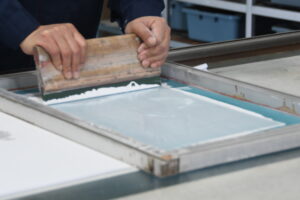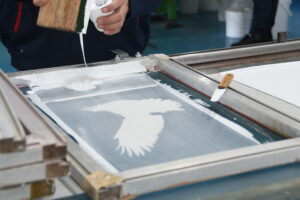Dive into the world of screen printing with our video guide on Plastisol vs. water-based ink. Perfect for creatives looking to master their craft!
Learn the best methods for screen printing with SHALITEINK. This guide will help you understand new products and features. Plastisol ink is a type of plastic ink used in screen printing, while water-based ink offers a softer, eco-friendly alternative. You will learn the right techniques to ensure print consistency and find high-quality SHALITEINK products. Textile printing techniques can be explored in our YouTube videos, providing valuable education on style, tools, and tips for future orders. Whether you are a beginner or a pro, this guide covers everything you need to know about screen printing techniques.

Table of Contents
- What is Plastisol Ink?
- What is Water-Based Ink?
- Plastisol vs. Water-Based Ink: Key Differences
- Pros and Cons
- When to Use Which Ink
- Expert Tips for Screen Printing
What is Plastisol Ink?
Plastisol ink is a popular choice among garment printers. It is a strong, thick ink best suited for screen printing on dark fabrics. Key points:
- PVC-based.
- Cures with heat for durability.
- Vibrant colors with high opacity.
- Works well with textile printers.
- Ideal for t-shirts, hoodies, and promotional items.
- Easy layering and even ink coverage.
- Compatible with SHALITEINK printing equipment.
What is Water-Based Ink?
Water-based ink uses water as its base, offering a soft and eco-friendly option. Key points:
- Penetrates fabric for a smooth, breathable print feel.
- Works best on light fabrics.
- Non-toxic and eco-friendly.
- Often used on sportswear and sustainable fashion.
- Requires air drying or heat curing.
- Suitable for detailed textile designs.
- Complements SHALITEINK sustainable printing solutions.
Plastisol vs. Water-Based Ink: Key Differences
| Feature | Plastisol Ink | Water-Based Ink |
|---|---|---|
| Opacity | High opacity; best for dark fabrics | Medium opacity; pre-treatment recommended |
| Print Feel | Thick and raised | Soft and breathable |
| Curing Process | Heat cure (20-30 sec at 320°F) | Air drying or heat curing (30-60 sec) |
| Durability | 50+ washes without fading | 20-30 washes; may fade |
| Eco-friendliness | Less eco-friendly | Eco-friendly and biodegradable |
| Ease of Use | Beginner friendly | Requires more cleaning and care |
| Cost | Lower per liter | Slightly higher due to eco-friendly components |
Pros and Cons
Plastisol Ink:
Pros:
- Vibrant colors.
- High opacity for dark fabrics.
- Durable prints.
- Easy layering.
- Quick curing with heat.
- Works with SHALITEINK printing mesh and frames.
Cons:
- Not eco-friendly.
- Stiff feel on fabric.
- Requires heat curing.
Water-Based Ink:
Pros:
- Soft, breathable print feel.
- Eco-friendly and biodegradable.
- Ideal for detailed designs.
- Great for sustainable projects.
- Works well with SHALITEINK eco-solutions.
Cons:
- Less durable; may fade faster.
- Requires fabric pre-treatment.
- Longer drying time.
When to Use Which Ink
Use Plastisol Ink When:
- You need vibrant colors.
- Printing on dark fabrics.
- Looking for durability.
- Producing large orders quickly.
- Creating promotional items or custom apparel.
Use Water-Based Ink When:
- A soft print feel is desired.
- Printing on light fabrics.
- Prioritizing eco-friendly practices.
- Designing for sportswear or activewear.
- Working on detailed, sustainable designs.
Expert Tips for Screen Printing
Plastisol Ink Tips:
- Use the correct heat press.
- Maintain proper screen printing mesh count.
- Mix inks thoroughly for consistent results.
- Test viscosity before large runs.
- Use flash cure units for bold designs.
- Try ink additives to enhance print finishing.
Water-Based Ink Tips:
- Pre-treat fabrics for better ink adhesion.
- Clean screens frequently to prevent clogging.
- Monitor ink drying methods for best results.
- Use color matching systems.
- Control ink penetration for smooth prints.

- Implement sustainable ink recycling programs.
General Tips:
- Invest in a good curing oven and ink heating system.
- Test prints with wash tests to ensure durability.
- Store ink properly in a cool, clean environment.
- Use personal safety equipment when handling chemicals.
Data and Statistics Table
| Category | Plastisol Ink | Water-Based Ink |
| Market Share | 65% of textile screen printing | 25% of textile screen printing |
| Average Cost per Liter | $10-$15 | $15-$20 |
| Curing Time | 20-30 sec at 320°F | 2-3 min air drying or 30-60 sec heat curing |
| Durability | 50+ washes | 20-30 washes |
| Environmental Impact | Contains PVC | Biodegradable and eco-friendly |
| Opacity | High for dark fabrics | Medium; pre-treatment needed |
| Ease of Use | Beginner-friendly | Requires careful screen cleaning |
Conclusion
Screen printing is a versatile craft that benefits from the right ink selection. Plastisol ink offers durability and bold colors, while water-based ink provides an eco-friendly and soft alternative. By understanding their differences and following expert tips, you can achieve the best results in your printing projects. SHALITEINK provides top-quality screen printing materials and resources to help you succeed in textile printing.
Use these insights to enhance your designs, improve print consistency, and ensure long-lasting results. Enjoy your craft and keep learning!

